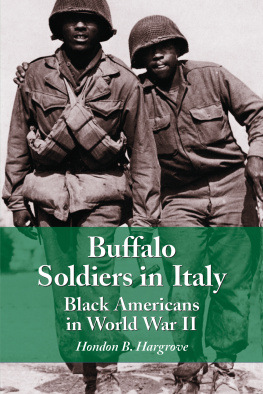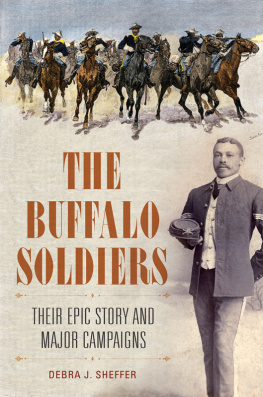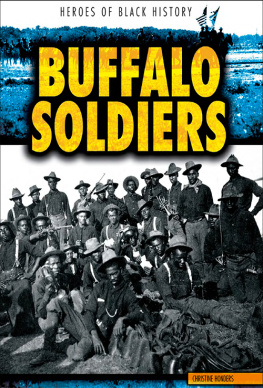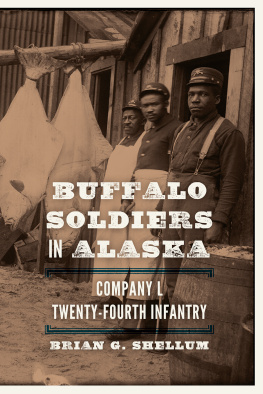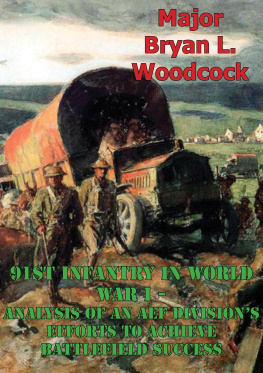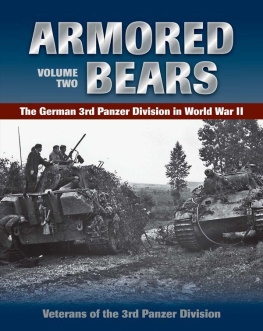To
First Lieutenant John R. Fox, 366th Infantry,
whose willing sacrifice of his life for his country
went unrecorded and unheralded for 38 years
(Distinguished Service Cross, Posthumous, April 1, 1982).
and
Second Lieutenant Vernon J. Baker, 370th Infantry,
for gallantry above and beyond the call of duty,
and at the risk of his own life (Distinguished Service Cross).
and
Those gallant Buffalo Soldiers who died in action
in a hostile foreign land,
surrounded by enemies of their country,
loved and remembered by their comrades in arms.
Buffalo Soldiers in Italy
Black Americans in World War II
by
Hondon B. Hargrove

McFarland & Company, Inc., Publishers
Jefferson, North Carolina, and London
Authors Note
History, many times, helps to right wrongs. With the inexorable passage of time, there are those of us who dare not trust memory or judgment to validate past events. Research, documentation, and reading of books by both American and foreign authors have helped this writer put together a book about the performance of the men in the Buffalo Division and its operations in Italy during World War II. Many Americans have passed on still wondering if they should or should not believe the generally negative image of this band of black soldiers. There are those who still remember and who will acknowledge that black soldiers performed no better and no worse than others who fought in Europe in World War II. The following bit of history may serve to dispel many myths and stories and give solace to those of us who suffered and survivedand relief from a lifetime of wondering by the families of those who died fighting for their country.
LIBRARY OF CONGRESS CATALOGUING-IN-PUBLICATION DATA
e-ISBN: 978-1-4766-2151-7
BRITISH LIBRARY CATALOGUING DATA ARE AVAILABLE
1985 Hondon B. Hargrove. All rights reserved
No part of this book may be reproduced or transmitted in any form or by any means, electronic or mechanical, including photocopying or recording, or by any information storage and retrieval system, without permission in writing from the publisher.
McFarland & Company, Inc., Publishers
Box 611, Jefferson, North Carolina
www.mcfarlandpub.com
Introduction
Of the ninety American divisions deployed in World War II, many have been the object of glowing accolades. Over the years, movies, books, magazines, and radio and television Specials have extolled their exploits. Even divisions which fought poorly or not at all, have been praised and credited with brilliant feats of arms. One, the 106th Infantry Division, was decimated in its first contact with the enemy in December, 1944, with over 70 percent of its effectives killed, wounded, or captured. Yet, a story in the Saturday Evening Post of 9 September, 1946 bore the title: The Glorious Collapse of the 106th.
Such, however, was not the case with the 92nd Infantry (Buffalo) Division, the only so-called black infantry division to see combat in Europe. Created in a season when complete segregation was prevalent in America, it was beset continuously by controversy because of the same rigid policy of segregation in the Army.
Except for a few chaplains and medical officers, all commanders and staff officers from division down through regiment and battalion levels, were white, as were most of the company commanders. All enlisted men were black.
In nine months of bitter combat in Italy, it was castigated by its commander, Major General Edward M. Almond, and his subordinate com-manders, as a failure, and the fighting capabilities of its black soldiers and officers were severely criticized. Stories of melting away and cowardly performance were published in news magazines and have been repeated in other media over the years. No black officer in the division was considered capable of commanding an infantry battalion and none were promoted to major.
Not surprisingly, prevailing animosities toward black people at the timeover the country and in the Armyled to negativism about black soldiers, contributing to the usually unfavorable evaluations by their com-manders.
Contrary to its commanders' evaluations, however, 12,096 decorations and citations were won by the Buffalo Soldiers: Among them were 3 Distinguished Service Crosses (second highest award for valor in combat), 16 Legion of Merit Medals, 102 Silver Stars, 753 Bronze Stars, 76 Air Medals, 1910 Purple Hearts, and the Military Cross for Merit in War was awarded by the Italian government.
These were more awards for valor in combat than many American divisions received.
Casualties were heavy and were incurred in direct contact with the enemy. Five hundred eighteen (518) were killed in action and 2242 were wounded in action; 67 died of wounds, and 21 were prisoners of war. Of these casualties, only 18 were officers above the rank of captain; all others were junior officers (mostly black) and enlisted men.
Of all American divisions, the Buffalo Division has been least ex-amined outside of the military establishment, yet in many ways it was one of the most fascinating and surprising of them all.
The purpose of this book is to complete the history of American arms in World War II by including the story of this unique and remarkable body of black soldiers.
Extensive research of military reports written in the field, staff orders and special reports, interviews with officers and menall reveal much factual information and insights that negate much of the general characterizations about them. The hope is that an interested reader will be able to draw his own conclusions about this black division and the courage of its men.
I am grateful to many people for help in this venture. Mrs. Sally Aschom provided expert counsel on format and typed the manuscript with great skill and patience. Mrs. Linda Peckham, Associate Professor of English at Lansing (Michigan) Community College, provided technical guidance and continuous inspiration and encouragement. Mr. Dennette A. Harrod, president of the 366th Infantry Veterans Association and a former comrade-in-arms, provided complete access to the records of the association. Dr. Norman McRae, Director of Social Studies, Detroit Public Schools, and a historian himself, provided sound advice and shared his extensive personal history library with me. Ms. Hannah M. Ziedlick, Historical Services Division, Center of Military History, Washington, D.C., provided invaluable assistance in research of official records and other necessary services. At the beginning of the research, Congressman John Conyers, Jr. helped to guide me through the maze of Federal rules and regulations and procedures, for which I am grateful. Major Clark, Lieutenant Colonel, Retired, and a former officer in the 92nd Division, provided copies of many records and a wealth of information. Mr. Hiram Tanner, of the Columbus Call and Post newspaper, and also a former Buffalo Soldier, also provided copies of records and much useful information.
My wife, Lilian M. Hargrove, a former reading specialist in the Lansing School District, reviewed the manuscript and endured with great patience my demands for time and space during the long period of research and writing.
Hondon B. Hargrove
Lansing, Michigan
One
Origins and Traditions
The First Buffalo Soldiers
It was late fall on the western prairies in the year 1867. The Indian wars were raging on the rapidly expanding frontier. High on a rocky ridge, two Indian scouts lay motionless and well-nigh invisible, eyes focused intently on the tall gates of the U.S. Army Post some two miles distant.
Next page
